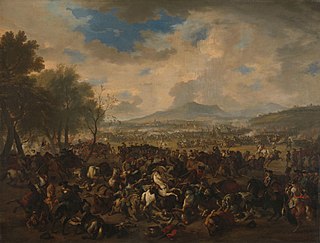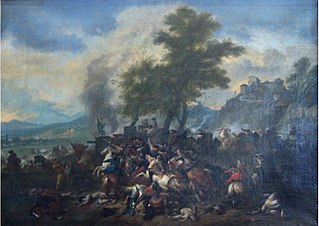| Division | Brigade | Regiments and Others |
|---|
1st Line (Infantry)
Lieutenant General Richard Ingoldsby | d'Herleville's Brigade
Major General d'Herleville
(Includes Stückrad's Brigade)
| - Schöpping Infantry Regiment (Hesse-Kassel) (400 men)
- Stückrad Infantry Regiment, Brigadier General Stückrad (Hesse-Kassel) (400 men)
- d'Herleville Infantry Regiment, Major General d'Herleville (Hanover-Calenberg) (400 men)
- von Tozin Infantry Regiment (Lüneburg-Celle) (400 men)
- Hulsen Infantry Regiment, Major General Hulsen (Hanover Calenberg) (400 men)
|
| Württemberg Brigade
Brigadier General Friederich Heinrich, Graf von Seckendorff
| - Württemberg Regiment Stenfels (571 men)
- Württemberg Regiment Hermann
- Württemberg Grenadier Regiment (833 men)
- Seckendorff's Infantry Regiment (Anspach-Bayreuth), Brigadier General Friedrich Heinrich, Graf von Seckendorff (573 men)
|
1st Line (Infantry)
Lieutenant General Horn | Holstein-Beck's Brigade
Major General Anton Günther, Fürst von Holstein-Beck
(Includes Heidebrecht's Brigade)
| - Heidebrecht Infantry Regiment, Brigadier General Heidebrecht (Ansbach/UP auxiliary) (599 men)
- Stürler Infantry Regiment (Swiss/UP auxiliary) (523 men)
- Hirzel Infantry Regiment (Swiss/UP auxiliary) (561 men)
- Rechteren Infantry Regiment (UP) (548 men)
- Goor Infantry Regiment (UP) (581 men)
|
| Dutch Mercenary Brigade
Major General Johan van Pallandt
| - Bynheim Infantry Regiment (Pfalz /UP auxiliary) (571 men)
- Schwerin Infantry Regiment, Colonel Kurt Christof, Graf von Schwerin (Mecklenburg-Prussian Meith Regiment) (547 men)
- de Varenne Infantry Regiment, Jacques l'Aumonier, Marquis de Varenne (Prussia/UP auxiliary) (461 men)
- Wulffen Infantry Regiment (Prussia/UP auxiliary) (591 men)
- Erbprinz von Hessen-Kassel Infantry Regiment, Erbprinz von Hessen-Kassel (Prussia/UP auxiliary) (540 men)
|
Left-center (cavalry)
Lieutenant General Cuno Josua von Bülow | Noyelles' Brigade
Major General Jacques-Louis Comte de Noyelles and Falais
| - Leib Horse Cuirassier Regiment (Hanover-Calenberg) (two squadrons, 150 men)
- Voigt's Horse Cuirassier Regiment (Hanover-Calenberg) (two squadrons, 150 men)
- Noyelles' Horse Cuirassier Regiment, Major General Jacques-Louis, comte de Noyelles and Falais (Hanover-Calenberg-Osnabrück/UP auxiliary) (two squadrons, 150 men)
|
| Viller's Brigade
Major General Viller
| - von Bülow's Dragoons Regiment (Lieutenant General Cuno Josua von Bülow (Hanover-Calenberg) (three squadrons, 225 men)
- Viller's Dragoons (Lüneburg-Celle) (four squadrons, 320 men)
- Bothmer's Dragoons, Brigadier General Bothmer (Lüneburg-Celle) (four squadrons, 320 men)
|
2nd Line (cavalry)
Lieutenant General Graf von Hompesch | Hesse-Homberg's Brigade
Major General Friedrich, Prinz von Hessen-Homburg
| - Leib Horse Regiment (Hesse-Kassel/UP auxiliary) (two squadrons, 160 men)
- Spiegel's Karabinere (Hesse-Kassel/UP auxiliary) (two squadrons, 160 men)
|
| Schulenburg's Brigade
Major General Alexander von der Schulenburg
| - Schulenburg's Dragoons (Hanover-Calenberg) (two squadrons, 150 men)
- Breidenbach's Horse Regiment (Hanover-Calenberg & Lüneburg-Celle) (two squadrons, 160 men)
|
| Erbach's Brigade
Major General Erbach
| - Erbach's Horse Cuirassier Regiment, Major General Erbach (UP) (two squadrons, 200 men)
- Baldwin's Horse, Brigadier General Baldwin (UP) (one squadron, 100 men)
- Schmettau's Dragoons, Gottlieb Schmettau (Ansbach) (four squadrons, 400 men)
|
Cavalry
Lieutenant General Friedrich Ulrich, comte de Oostfries | Vittinghoff's Brigade
Lieutenant General Vittinghoff
| - Grevendorff's Dragoons, Brigadier General Grevendorff (Saxe-Gotha) (three squadrons, 240 men)
- Hardenberg's Dragoons (Saxe-Gotha) (three squadrons, 240 men)
- Sachsen-Heilburg Horse Regiment (UP) (two squadrons, 200 men)
- Bannier's Horse Regiment (Hanover-Calenberg) (two squadrons, 150 men)
|
| Auroch's Brigade
Major General Auroch
| - Erbach's Horse Regiment, Major General Erbach (Hesse-Kassel) (two squadrons, 160 men)
- Auroch's Dragoons, Major General Auroch (Hesse-Kassel) (four squadrons, 320 men)
|
Lieutenant General Karl Rudolf, Fürst von Württemberg-Neuenstadt | Rantzau's Brigade (Denmark/UP auxiliary)
Brigadier General Jørgen von Rantzau
| - 2nd Sjællandske Horse Regiment, Brigadier General Jørgen von Rantzau (two squadrons, 585 men
- 5th Jydske Regiment of Horse, Colonel Wilhelm von Schmettau (two squadrons, 440 men)
- 4th Jydske Regiment of Horse, Brigadier General Jørgen von Rantzau (two squadrons, 440 men)
- Livregimentet Rytter, Colonel Christian Detlev von Reventlow (two squadrons of six companies, 556 men)
- Württemberg-Öls Dragoons, Carl Friedrich, Herzog von Württemberg-Öls (three squadrons of ten companies, 1,007 men)
|
| Brockdorff's Brigade (Denmark/England auxiliary)
Brigadier General Ditlev von Brockdorff
| - 3rd Jydske Horse Regiment, Colonel Ditlev von Brockdroff (two squadrons, 591 men)
- Ahlefeldt's Horse Cuirassier Regiment (two squadrons, 589 men)
- 2nd Jydske Horse Regiment, Colonel von Uterwick Prehn (two squadrons, 568 men)
- Holstein's Horse Cuirassier Regiment, Colonel Dewitz (two squadrons, 578 men)
- Württemberg-Ōls Dragoons, Carl Friedrich, Herzog von Württemberg-Ōls (two squadrons of ten companies, 589 men)
|
| von Rantzau's Brigade
Major General Jørgen von Rantzau
| - 1st Battalion, Rantzau, Major General Jørgen von Rantzau (Lüneburg-Celle/UP auxiliary) (588 men)
- 2nd Battalion, Rantzau, Major General Jørgen von Rantzau (Lüneburg-Celle/UP auxiliary) (636 men)
- Bernsdorff Infantry Regiment, Brigadier General Bernsdorff (Lüneburg-Celle/UP auxiliary) (531 men)
- Teckelenberg Infantry Regiment (Hanover-Calenberg/UP auxiliary) (532 men)
- St. Paul Infantry Regiment, St. Paul des Estanges (Hanover-Calenberg/UP auxiliary) (520 men)
|
Infantry
Lieutenant General Lord Orkney | Webb's Brigade
Major General John Richmond Webb
| |















